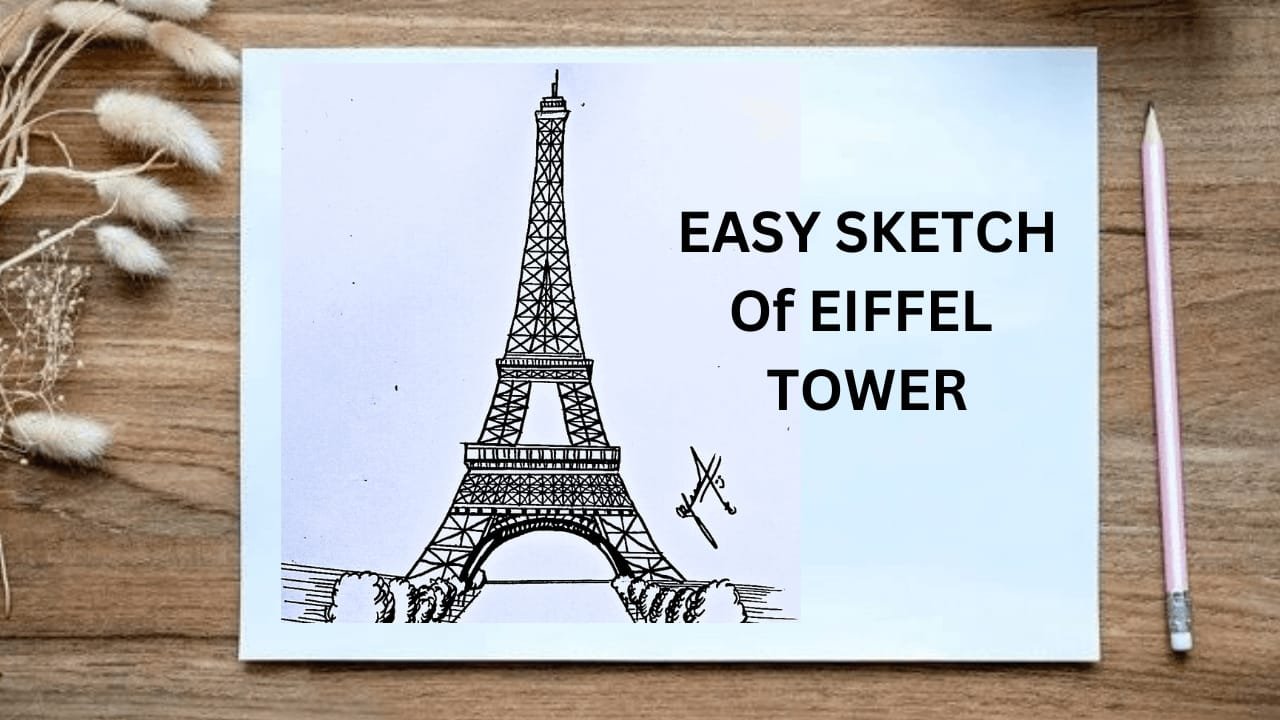Introduction to Easy Sketch Eiffel Tower
The Simple Sketch Eiffel Tower is a wonderful and open way for craftsmanship fans, everything being equal, to catch the famous Parisian milestone. This improved approach separates the intricate design into sensible advances, making it ideal for fledglings and specialists. With simple guidelines, anybody can reproduce the tastefulness and appeal of the Eiffel Tower with only a pencil and paper. The cycle not only enhances drawing abilities, but also instills an appreciation for one of the world’s most popular structural wonders. Whether for a great evening movement or as a prologue to drawing milestones, the Simple Sketch Eiffel Tower gives a compensating imaginative encounter that celebrates innovativeness and the immortal excellence of the Eiffel Tower.Also read Easy sketch of car lamborghini
Materials Required for Easy Sketch Eiffel Tower
To set out on the pleasant excursion of drawing the Eiffel Tower, you’ll require a couple of fundamental materials that are promptly accessible and simple to utilize. As a matter of some importance, you’ll require a decent-quality sketchbook or a heap of drawing paper. A smooth, corrosive-free paper is ideal, as it gives a spotless surface that can deal with deleting and modifying without harm. Then, a bunch of graphite pencils is urgent, going from delicate (B) to hard (H) leads. The gentler pencils (like 2B or 4B) are brilliant for concealing and adding profundity, while the harder ones (like 2H or 4H) are ideally suited for better subtleties and light outlining.
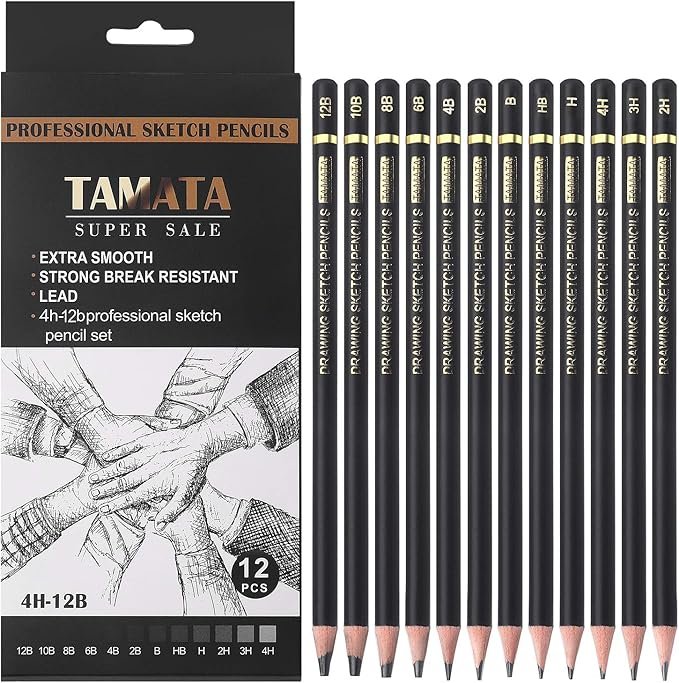
An eraser is irreplaceable, especially a plied eraser, which considers delicate, exact rectifications without smearing your work. A ruler will assist you with keeping up with precise extents and straight lines.
Step-by-Step Guide to Sketching the Eiffel Tower
Depicting the Eiffel Tower can be a magnificent and enthralling experience, regardless, for youngsters. This little by little aide will help you with making a certain sketch of this striking Parisian achievement right now.
1. Frame the Essential Construction
Begin by attracting an upward centerline to assist with keeping your sketch balanced. This line addresses the focal hub of the Eiffel Tower. Then, define a flat boundary close to the lower part of your paper to show the base.
Partition the upward line into four areas, addressing the four levels of the tower. The primary segment (from the base) will be the tallest, as it incorporates the tower’s legs and first stage. The excess three segments will get dynamically more limited.

2. Draw the legs.
From the base flat line, define two inclining boundaries that bend somewhat outward. These lines will shape the inward sides of the tower’s legs. Then, define two additional askew boundaries outside the main pair, bending outward considerably more. These lines structure the external edges of the legs. The legs ought to be more extensive at the base and tighten as they rise.
Interface the highest point of every leg with a bended line, framing the main stage. This stage ought to be marginally more extensive than the distance between the internal edges of the legs.
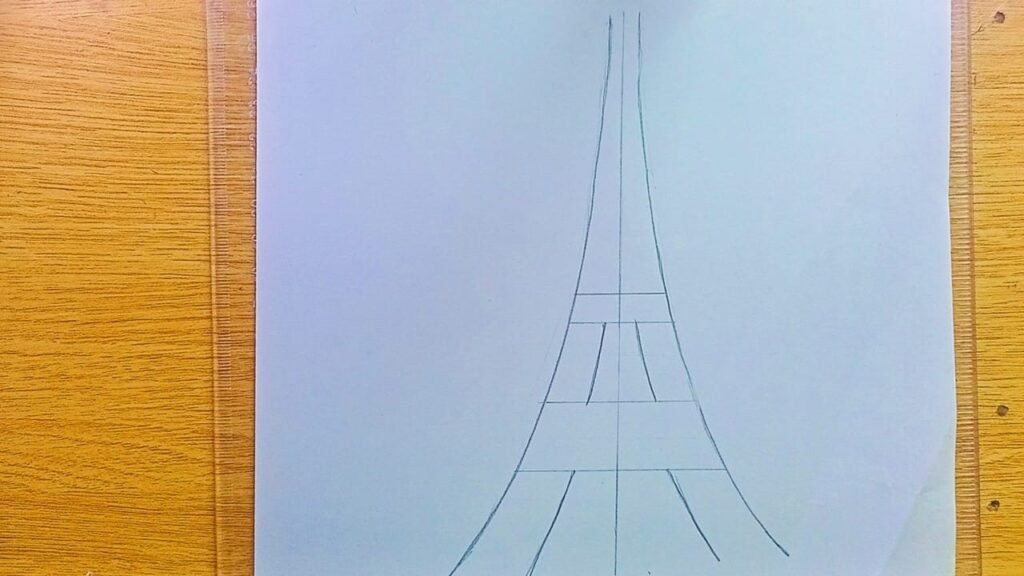
3. Add the center segment.
Over the principal stage, draw one more set of slanting lines that tighten internally to frame the center part of the tower. These lines ought to be more limited than the ones framing the legs. Add a flat line at the highest point of this segment to make the subsequent stage.
Rehash this move toward drawing the third part of the tower, which is more limited still. The lines ought to unite all the more pointedly toward the centerline. Add the third stage at the highest point of this part.
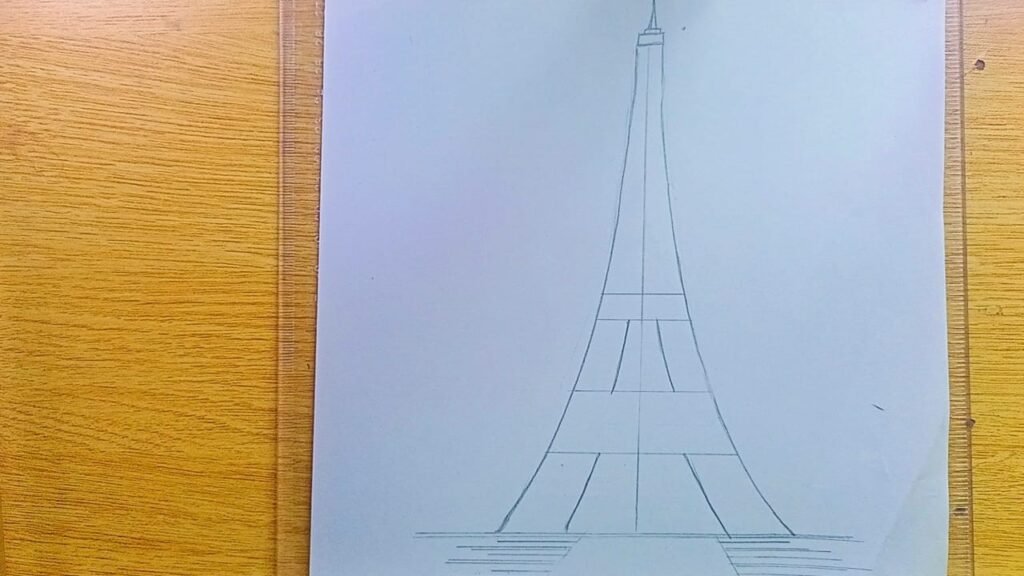
4. Draw the upper segment.
Over the third stage, draw a solitary, limited, three-sided segment addressing the highest piece of the Eiffel Tower. This part ought to tighten to a point at the top, addressing the receiving wire.
5. Add subtleties to the design.
Since you have the essential layout, begin adding more detail to the design. Define extra-even boundaries to separate the legs into fragments, imitating the grid-like design of the tower. Add vertical lines inside each fragment to make a framework design.
On the principal stage, define little vertical and slanting boundaries to address the railings and latticework. Rehash this interaction for the second and third stages, ensuring the subtleties become more modest and less conspicuous as you climb the tower.
6. Sketch the openings.
At the foundation of the tower, draw the enormous passages between the legs. Begin by defining a bended boundary from the external edge of one leg to the external edge of the contiguous leg. Inside this bend, draw a more modest, equal bend to give the curve profundity. Rehash this cycle for every one of the four sides.

7. Add Textural Subtleties
To give your sketch more aspect and authenticity, add textural subtleties to the legs and body of the tower. Utilize short, fast strokes to address the mind-boggling latticework. Differ the heading and length of these strokes to create a feeling of profundity and surface.

8. Refine the receiving wire.
At the highest point of the tower, refine the receiving wire by adding a couple of even vertical lines. This will give the receiving wire more design and make it look more point-by-point.
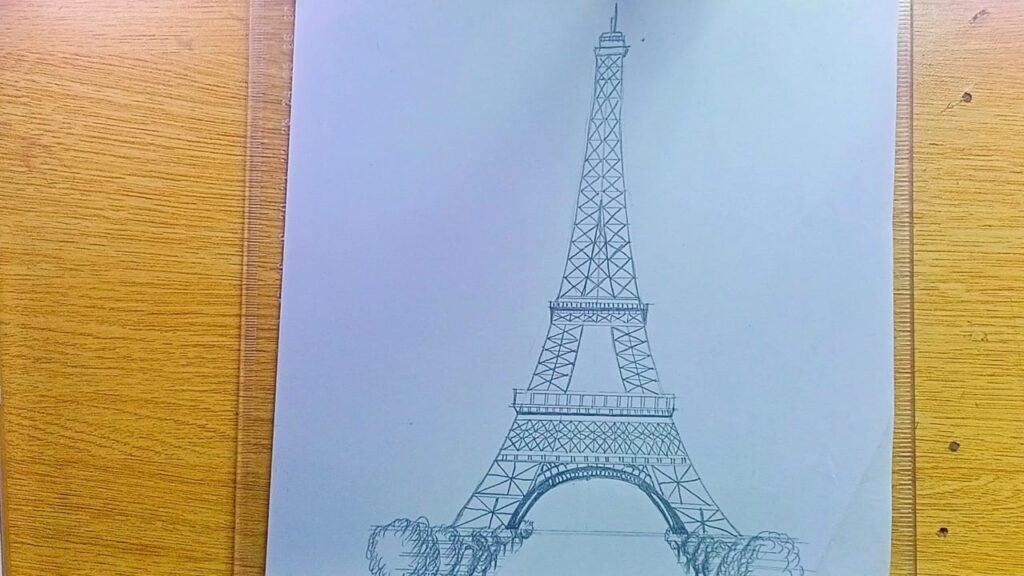
9. Shade and Feature
To add profundity and difference to your sketch, apply concealment. Distinguish the light source heading in your sketch. Conceal the sides of the tower that are in shadow by utilizing bring-forward or cross-incubating procedures. Obscure the regions under the stages and inside the entrances to accentuate profundity.
Leave the regions that get the most light (for example, the highest points of the stages and the edges confronting the light source) lighter. This difference will cause your sketch to show up more three-layered.

10. Last Contacts
Survey your sketch for any areas that need refining or extra subtleties. Tidy up any superfluous lines with an eraser and obscure the last lines to make your sketch stick out. Add any last contacts, for example, more textural subtleties or extra overshadowing, to finish your sketch.
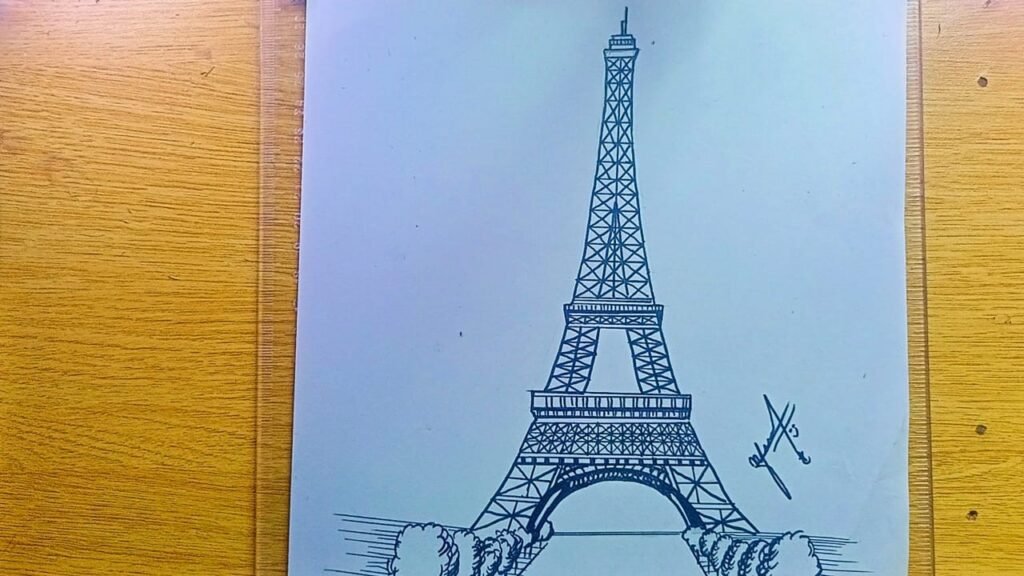
By following these means, you can make a conspicuous and nitty-gritty sketch of the Eiffel Tower. This interaction includes developing the construction from the beginning, adding layers of detail, and refining your work with concealment and surface. Practice and tolerance are critical; each sketch will work on how you might interpret the tower’s many-sided plan. Partake all the while and invest wholeheartedly in your creative portrayal of this notable milestone.
Tips for Beginners to Easily Sketch the Eiffel Tower
Portraying the Eiffel Tower can be a compensating project for fledglings, and with the right methodology, you can make a wonderful portrayal of this notable milestone. Here are a few hints to assist you with getting everything rolling:
Assemble Your Materials:
Guarantee you have every one of the important materials: a sketchbook or drawing paper, a bunch of graphite pencils (going from 2H to 4B), a worked eraser, a ruler, a pencil sharpener, and a reference picture of the Eiffel Tower.
Concentrate on your reference picture.
Find the opportunity to painstakingly concentrate on the reference picture you’ve picked. Notice the fundamental shapes and how they connect with one another. Focus on the extent and the general design of the tower.
Begin with essential shapes and shapes:
Start your sketch by daintily attracting fundamental shapes to address the Eiffel Tower. Utilize basic mathematical shapes like triangles, square shapes, and trapezoids. This aides in separating the complicated design into additional reasonable parts. Draw delicately so you can, without much of a stretch, eradicate and change depending on the situation.
Center around Extents:
Utilize your ruler to assist with keeping up with precise extents. Measure the level and width of various areas of the tower and contrast them with one another. This step is vital to guaranteeing your sketch looks like the Eiffel Tower’s novel construction.
Fabricate the construction progressively.
When you have the essential shapes and extents set up, begin refining your sketch. Add more subtleties continuously, working from the highest point of the tower downward. downward. This deliberate methodology keeps up with the design and tries not to overpower you with an excessive number of subtleties on the double.
Add Subtleties and Surfaces:
The Eiffel Tower has numerous many-sided subtleties, particularly in the latticework. Utilize your harder pencils (H leads) for these fine subtleties. Try not to stress over catching each and every component; center around the most unmistakable highlights that characterize the tower’s appearance.
Shade and add significance:
Covering adds significance and credibility to your sketch. Use milder pencils (B leads) for covering. covering. Shine on the light source in your reference picture and apply concealment in a similar manner. Blend your covering in with a blending stump or tortillon to achieve smoothness.
Use Eraser for Features:
A plied eraser can be formed to make exact features. Tenderly lift graphite from regions where the light raises a ruckus around town most, upgrading the three-layered impact.
Enjoy Reprieves and Survey:
Drawing can escalate, so enjoy reprieves to rest your eyes and hands. At the point when you return to your work, survey it with a new perspective. You could see regions that need change or improvement.
Practice tolerance and perseverance. perseverance.
Drawing the Eiffel Tower, particularly for amateurs, requires tolerance. Try not to rush the cycle. Practice consistently, and cheer up by beginning outcomes. With time and perseverance, your abilities will improve, and your representations will turn out to be more refined.
By following these tips and rehearsing routinely, you’ll have the option to make a delightful sketch of the Eiffel Tower that you can be grateful for. Partake all the while and praise your advancement en route!
What to Avoid During an Eiffel Tower Sketch
Drawing the Eiffel Tower can be an invigorating yet testing attempt for amateurs. To guarantee a smooth and charming experience, it’s vital to be aware of normal traps. Here are key things to stay away from during your outlining cycle:
Avoiding the nuts and bolts:
Try not to jump into the mind-boggling subtleties immediately. Begin with fundamental shapes and diagrams to lay out the general design and extent. This central step is significant for accomplishing a fair and exact portrayal.
Disregarding Extents:
Extents are essential to catching the Eiffel Tower’s particular shape. Utilize a ruler to gauge and look at changed segments. Skirting this step can prompt a contorted or unrecognizable sketch.
Squeezing Excessively Hard with the Pencil:
Squeezing too hard can make it challenging to delete errors and make undesirable scores in the paper. Begin with light, delicate lines that can be effectively changed or deleted.
Overburdening on Subtleties Too Soon:
It’s enticing to jump into the many-sided latticework right away; however, keep away from this until you have the essential construction and extents set. Adding subtleties too soon can overpower you and make redresses more troublesome.
Ignoring Light Sources and Concealing:
Concealing adds profundity and aspect to your sketch. Try not to disregard the light source in your reference picture. Mistaken concealing can make your sketch look level and ridiculous. Focus on how light and shadow interact in the design.
Utilizing One Sort of Pencil:
Utilizing just a single type of pencil can restrict the scope of tones and surfaces in your sketch. Try not to adhere to a solitary pencil and use a range of hardness (2H to 4B) to accomplish various impacts and subtleties.
Neglecting to Enjoy Reprieves:
Extensive stretches of centered portraying can prompt weariness, which can influence the nature of your work. Try not to work for a really long time without breaks. Step back infrequently to rest your eyes and hands and to survey your work from a new point of view.
Being Anxious:
Persistence is key in outlining, particularly with a complicated subject like the Eiffel Tower. Try not to hurry through the interaction. Take as much time as necessary to guarantee exactness and accuracy.
Disregarding Missteps:
No one’s perfect, particularly while learning. Abstain from disregarding them or becoming deterred. Utilize an eraser to address mistakes and view them as learning opportunities.
Contrasting Yourself with Others:
Try not to contrast your advancement with others. Everybody has a unique style and speed of learning. Center around your own improvement and partake in the imaginative excursion.
By being aware of these normal entanglements and zeroing in on a deliberate, patient methodology, you’ll upgrade your capacity to portray the Eiffel Tower successfully and charmingly.
Frequently Asked Questions (FAQs)
1. What materials do I have to draw the Eiffel Tower?
To portray the Eiffel Tower, you will require a sketchbook or drawing paper, a bunch of graphite pencils (going from 2H to 4B), a plied eraser, a ruler, a pencil sharpener, and a reference picture of the Eiffel Tower. Discretionary, however supportive, devices incorporate mixing stumps or tortillons for concealment.
2. How would I begin my sketch of the Eiffel Tower?
Start by concentrating on your reference picture and separating the tower into essential mathematical shapes like triangles, square shapes, and trapezoids. Gently sketch these shapes to frame the tower’s design prior to adding better subtleties.
3. How might I keep up with precise extents?
Utilize a ruler to gauge and look at the changed segments of the tower. Mark central issues and rules to assist with keeping your extents precise. Consistently step back to survey your sketch and make changes on a case-by-case basis.
4. What procedures could I at any point use for concealment?
Concealing adds profundity and authenticity to your sketch. Utilize milder pencils (B leads) for concealing and apply changing strain to make various tones. Mix your concealing with stumps or tortillons to achieve smooth slopes. Focus on your light source to guarantee exact overshadowing.
5. How would I add subtleties to the Eiffel Tower?
Subsequent to laying out the fundamental construction, steadily add subtleties, zeroing in on each segment in turn. Utilize more diligent pencils (H leads) for better subtleties. Try not to attempt to catch each component; focus on the most conspicuous highlights to address the tower’s perplexing plan.
6. How would it be a good idea for me to respond in the event that I commit an error?
Botches are important for the growing experience. Utilize a manipulated eraser to delicately lift graphite without smirching. Go ahead, make adjustments, and gain from each endeavor. Keep your underlying lines light to make deleting simpler.
7. How might I further develop my portrayal abilities?
Practice routinely and show restraint toward yourself. Read up on other specialists’ work for motivation and procedures. Center around various parts of outlining, like extents, concealing, and enumerating, and look for criticism from individual craftsmen or teachers.
8. Might I at any point involve variety in my Eiffel Tower sketch?
Totally! While conventional portrayals frequently use graphite, adding variety can upgrade your drawing. Utilize hued pencils, markers, or watercolors to rejuvenate your sketch. Focus on the tower’s lighting and shadowing to keep up with authenticity and variety.
Conclusion
Outlining the Eiffel Tower is a rewarding endeavor that combines innovativeness and specialized expertise. By beginning with essential shapes, keeping up with precise extents, and slowly adding subtleties, you can make a wonderful portrayal of this notable milestone. Keep away from normal traps like hurrying, disregarding extents, and squeezing excessively hard with your pencil. All things considered, take as much time as is needed, utilize the right materials, and practice tolerance and steadiness. Make sure to partake simultaneously, embrace botches as learning opportunities, and ceaselessly refine your methods. Whether you stick to graphite or integrate variety, each sketch is a stage towards working on your creative capacities. With devotion and standard practice, you’ll find your representations turning out to be more definite and exact, catching the class and intricacy of the Eiffel Tower. Continue to draw, remain roused, and praise your advancement on this imaginative excursion.

